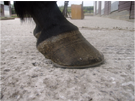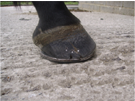Foot Ailments - Sand Cracks
A sand crack is a fissure of the wall which commences at the coronet and extends a variable distance down the hoof. It can be at the toe, heels, quarters or in the bars. A complete sand crack extends from the coronet to the ground surface and an incomplete sand crack extends only part way. There are two types of sand cracks: simple - which do not go as deep as the sensitive structures and complicated - which will involve the sensitive structures and cause lameness and sometimes infection.
Sand cracks are associated with dry hooves where weight is taken unevenly and they are more frequent in dry brittle hooves. They tend to occur at the toe in more upright feet and towards the heels on flat footed horses. The crack will only disappear when it has grown out and been replaced by new horn.
Treatment of simple sand cracks is to try and restrict further movement between the sides of the crack by isolating the affected part of the hoof wall. If the crack is incomplete then you should cut two grooves in the shape of a V from the coronet to the extremity of the crack. If it is complete then there should be two grooves one on each side (outside) running vertically from coronet to ground surface. However if the sand crack is complicated then it is necessary to hold the wall together with some sort of mechanical method e.g.: nail or sand crack staple.
To date I have yet to come across a complicated sand crack, however a new horse arrived on one of our yards with the feet as shown. This horse was obviously well overdue for shoeing and also suffered from very dry & brittle feet. This is a prime suspect for false sand cracks and as shown there was one on its off fore foot.
A false sand crack is a simple crack which commences at the ground surface and extends a variable distance up the hoof. One possible cause for these false sand cracks is if the shoe has been fitted too close and the wall protrudes over the edge of the shoe.
We watched this horse walk up and down and it was quite clear that he was toe landing, which in turn put much more pressure on the toe area. Together with the fact that the feet were very dry, these factors clearly contributed to the sand crack. After discussion we decided to bring the break over as far back as possible to help land on the heels and also to give him some length and help support the brittle heels to avoid any collapse. With this in mind, we decided it would be best to fit him with natural balance fronts.
As I trimmed the feet there was over an inch to come off the toe, indicating that it was a while since the job was last done. I also dressed the walls back and in the process I removed the majority of the sand crack. This means the false sand crack was only superficial and with a stricter schedule for shoeing we should be able to avoid any more. Once I had finished the job he walked off heels first to the delight of the client at the horse’s pretty new feet.



 Back to Hints & Tips
Back to Hints & Tips